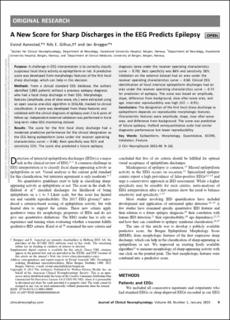| dc.contributor.author | Aanestad, Eivind | |
| dc.contributor.author | Gilhus, Nils E | |
| dc.contributor.author | Brøgger, Jan | |
| dc.date.accessioned | 2021-08-10T14:42:14Z | |
| dc.date.available | 2021-08-10T14:42:14Z | |
| dc.date.created | 2021-05-14T10:55:45Z | |
| dc.date.issued | 2023 | |
| dc.identifier.issn | 0736-0258 | |
| dc.identifier.uri | https://hdl.handle.net/11250/2767233 | |
| dc.description.abstract | Purpose: A challenge in EEG interpretation is to correctly classify suspicious focal sharp activity as epileptiform or not. A predictive score was developed from morphologic features of the first focal sharp discharge, which can help in this decision.
Methods: From a clinical standard EEG database, the authors identified 2,063 patients without a previous epilepsy diagnosis who had a focal sharp discharge in their EEG. Morphologic features (amplitude, area of slow wave, etc.) were extracted using an open source one-click algorithm in EEGLAB, masked to clinical classification. A score was developed from these features and validated with the clinical diagnosis of epilepsy over 2 to 6 years of follow-up. Independent external validation was performed in Kural long-term video-EEG monitoring dataset.
Results: The score for the first focal sharp discharge had a moderate predictive performance for the clinical designation as the EEG being epileptiform (area under the receiver operating characteristics curve = 0.86). Best specificity was 91% and sensitivity 55%. The score also predicted a future epilepsy diagnosis (area under the receiver operating characteristics curve = 0.70). Best specificity was 86% and sensitivity 38%. Validation on the external dataset had an area under the receiver operating characteristics curve = 0.80. Clinical EEG identification of focal interictal epileptiform discharges had an area under the receiver operating characteristics curve = 0.73 for prediction of epilepsy. The score was based on amplitude, slope, difference from background, slow after-wave area, and age. Interrater reproducibility was high (ICC = 0.91).
Conclusions: The designation of the first focal sharp discharge as epileptiform depends on reproducible morphologic features. Characteristic features were amplitude, slope, slow after-wave area, and difference from background. The score was predictive of future epilepsy. Halford semiquantitative scale had similar diagnostic performance but lower reproducibility. | en_US |
| dc.language.iso | eng | en_US |
| dc.publisher | Wolters Kluwer | en_US |
| dc.rights | Attribution-NonCommercial-NoDerivatives 4.0 Internasjonal | * |
| dc.rights.uri | http://creativecommons.org/licenses/by-nc-nd/4.0/deed.no | * |
| dc.title | A New Score for Sharp Discharges in the EEG Predicts Epilepsy | en_US |
| dc.type | Journal article | en_US |
| dc.type | Peer reviewed | en_US |
| dc.description.version | publishedVersion | en_US |
| dc.rights.holder | Copyright 2021 The Authors | en_US |
| cristin.ispublished | true | |
| cristin.fulltext | original | |
| cristin.qualitycode | 1 | |
| dc.identifier.doi | 10.1097/WNP.0000000000000849 | |
| dc.identifier.cristin | 1909977 | |
| dc.source.journal | Journal of clinical neurophysiology | en_US |
| dc.source.pagenumber | 9-16 | |
| dc.identifier.citation | Journal of clinical neurophysiology. 2023, 40 (1), 9-16. | en_US |
| dc.source.volume | 40 | |
| dc.source.issue | 1 | |

